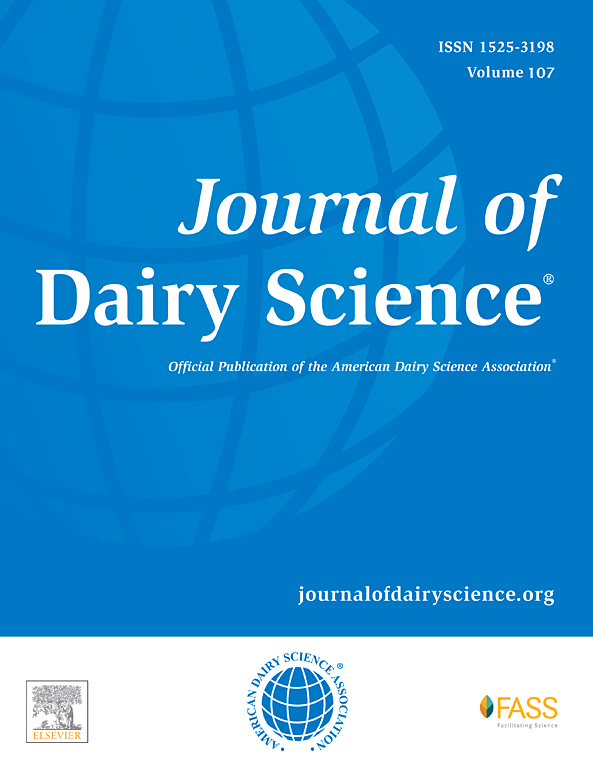特邀评论:从饲粮脂肪到脂肪酸——脂肪酸如何影响奶牛消化率、代谢和生产性能的新见解
IF 4.4
1区 农林科学
Q1 AGRICULTURE, DAIRY & ANIMAL SCIENCE
引用次数: 0
摘要
在乳制品营养学中,“脂肪”泛指主要由脂肪酸(FA)组成的脂类化合物,脂肪酸在消化、代谢和产奶过程中发挥着多种作用。奶牛饲粮中的主要FA有棕榈酸(16:0)、硬脂酸(18:0)、油酸(18:1)、亚油酸(18:2)和亚麻酸(18:3)。在瘤胃中,脂肪酸被广泛修饰,这降低了UFA对瘤胃细菌的毒性。瘤胃细菌也能从瘤胃发酵终产物和AA合成FA,主要生产奇链和支链FA。当游离脂肪酸流入肠道时,消化率受到几个因素的影响。这些包括总FA流量,FA轮廓,乳化化合物的存在,以及脂肪补充剂的物理特性。FA的消化率通常随着总FA摄入量和流向肠道的增加而降低,特别是18:0时,其消化率比16:0时下降更明显。部分日粮UFA逃避了瘤胃生物氢化。因此,添加含18:1的共混物可以增加其经胃排出量,提高FA的消化率和吸收。这些影响在泌乳早期和高产奶牛中尤其有益。此外,补充剂的形式和纯度影响FA的吸收,高饱和和纯补充剂的消化率较低。日粮中18-碳FA的来源也会影响消化率,与提供18:0的颗粒补品相比,油籽补品的消化率降低幅度较小。从历史上看,植物油中常见的UFA和中链FA由于多种机制(包括纤维颗粒的涂层、微生物毒性和阳离子可用性降低)而对NDF消化率产生负面影响。然而,最近的研究表明,高16:0的FA来源可以提高NDF的消化率。这些改善与DMI的减少无关,这表明可能涉及其他机制,如肠道肽活性的改变或微生物群落的变化。在生产反应方面,添加16:0的乳脂能持续提高乳脂产量、ECM和泌乳期养分利用率。相比之下,在高产奶牛(产奶量大于45 kg/d)和泌乳早期,饲粮比例为18:1可提高体重增重和FA消化率,尤其有效地提高泌乳早期奶牛的体外代谢。同时,18:0经常降低FA消化率,限制其生产效益。在多项研究中,含有更高比例16:0的混合物,特别是与18:0相比,导致乳脂产量和ECM呈线性增加,支持乳腺中优先使用16:0进行脂肪合成。虽然一些早期的研究表明,在补充剂中结合16:0和18:0可以优化FA的利用率,但这种方法在很大程度上被最近的研究结果所质疑。高水平18:0的FA补充剂已被证明会降低FA的消化率和能量摄入,限制了它们在大多数生产环境中的价值。在哺乳早期,混合含有16:0和18:1的混合物比其他只含有16:0或16:0 + 18:0的补充剂产生更好的生产反应。总的来说,我们的综述强调了FA消化和代谢的复杂性,并强调了根据奶牛的生产阶段和生理状态以及期望的结果定制补充策略的重要性。未来的研究应改进膳食配方,以优化能量分配,提高生产力,并支持整个哺乳期的代谢健康。本文章由计算机程序翻译,如有差异,请以英文原文为准。
Invited review: Moving from dietary fat to fatty acids—New insights into how fatty acids affect digestibility, metabolism, and performance in dairy cows
In dairy nutrition, “fat” broadly refers to lipid compounds primarily composed of fatty acids (FA), which play diverse roles in digestion, metabolism, and milk production. The main FA present in dairy cow diets are palmitic (16:0), stearic (18:0), oleic (18:1), linoleic (18:2), and linolenic (18:3) acids. In the rumen, FA are extensively modified, which decreases the toxicity of UFA to rumen bacteria. Rumen bacteria can also synthesize FA from end products of rumen fermentation and AA, primarily producing odd- and branched-chain FA. As FA flow to the intestine, digestibility is influenced by several factors. These include total FA flow, FA profile, the presence of emulsification compounds, and the physical characteristics of fat supplements. The digestibility of FA typically decreases as total FA intake and flow to the intestine increase, especially with 18:0, which exhibits a more pronounced reduction in digestibility than 16:0. Some dietary UFA escape rumen biohydrogenation. Therefore, supplemental blends containing 18:1 can increase its postruminal delivery, improving FA digestibility and absorption. These effects are especially beneficial during early lactation and in high-producing cows. Additionally, the form and purity of supplements influence FA absorption, with highly saturated and pure supplements having lower digestibility. The source of 18-carbon FA in the diet also affects digestibility, with oilseeds being associated with less reduction in digestibility than prilled supplements that provide 18:0. Historically, UFA and medium-chain FA, commonly found in vegetable oils, have been shown to negatively affect NDF digestibility due to various mechanisms, including the coating of fiber particles, microbial toxicity, and reduced cation availability. However, recent studies indicate that FA sources high in 16:0 can enhance NDF digestibility. These improvements are not linked to reduced DMI, suggesting that other mechanisms, such as altered gut peptide activity or microbial community shifts, may be involved. In terms of production responses, 16:0 supplementation consistently improves milk fat yield, ECM, and nutrient utilization across lactation. In contrast, 18:1 enhances BW gain and FA digestibility and is particularly effective in increasing ECM in high-producing cows (over 45 kg/d of milk yield) and cows in early lactation. At the same time, 18:0 often reduces FA digestibility, limiting its production benefits. Across multiple studies, blends containing higher proportions of 16:0, especially in comparison with 18:0, led to linear increases in milk fat yield and ECM, supporting the preferential use of 16:0 for fat synthesis in the mammary gland. Although some earlier work suggested that combining 16:0 and 18:0 in a supplement would optimize FA utilization, this approach has been largely discredited by recent findings. High levels of 18:0 in FA supplements have been shown to reduce FA digestibility and energy intake, limiting their value in most production contexts. Combining blends containing 16:0 and 18:1 resulted in better production responses during early lactation than other supplements containing only 16:0 or 16:0 + 18:0. Overall, our review highlights the complexity of FA digestion and metabolism and underscores the importance of tailoring supplementation strategies to the production stage and physiological status of dairy cows and the outcomes desired. Future research should refine dietary formulations to optimize energy partitioning, enhance productivity, and support metabolic health throughout lactation.
求助全文
通过发布文献求助,成功后即可免费获取论文全文。
去求助
来源期刊

Journal of Dairy Science
农林科学-奶制品与动物科学
CiteScore
7.90
自引率
17.10%
发文量
784
审稿时长
4.2 months
期刊介绍:
The official journal of the American Dairy Science Association®, Journal of Dairy Science® (JDS) is the leading peer-reviewed general dairy research journal in the world. JDS readers represent education, industry, and government agencies in more than 70 countries with interests in biochemistry, breeding, economics, engineering, environment, food science, genetics, microbiology, nutrition, pathology, physiology, processing, public health, quality assurance, and sanitation.
 求助内容:
求助内容: 应助结果提醒方式:
应助结果提醒方式:


